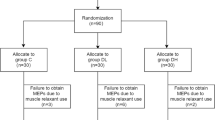Abstract
Total intravenous anesthesia and the new parameter for administering the most recent drugs, target-controlled infusion, as well as the introduction of new short half-life molecules that do not accumulate have made anesthesia in day surgery safer. In this study, the use of auditory-evoked potentials monitoring made it possible to determine the target plasma concentration of propofol that induces a narcosis sufficiently deep and strictly necessary for effectiveness, thus minimizing the anesthesiologic risk linked to the use and the dosing of the drug, reducing the hospitalization time, and decreasing the side effects for patients undergoing day surgery mammoplasty.
Similar content being viewed by others
References
Barr G, et al.: A study of bispectral analysis and auditory-evoked potential indices during propofol-induced hypnosis in volunteers: The effect of an episode of wakefulness on explicit and implicit memory. Anaesthesia 56:888–893, 2001
Breckenridge JL, et al.: Awareness during anaesthesia: A revue. Ann R Coll Surg 65:93–96, 1983
Ghoneim M, et al.: The auditory-evoked responses and learning and awarness during general anaesthesia, Acta Anaesthesiol. Scand 44:133–143, 2000
Jordan C, et al.: Monitoring-evoked potentials during surgery to assess the level of anaesthesia. J Med Eng Technol 19:77–79, 1995
Lehmann A, et al.: Bispectral index in patients with target-controlled or manually-controlled infusion of propofol. Anesth Analg 95:639–644, 2002
Loveman E, et al.: The auditory-evoked response as an awareness monitor during anaesthesia. Br J Anaesth 86:513–519, 2001
Padfield NL: Total intravenous anesthesia. Williams & Wilkins: Baltimore, 1997
Suttner S, et al.: Cost analysis of target-controlled infusion-based anesthesia compared with standard anesthesia regimens. Anesth Analg 88:77–82, 1999
Thornton C, et al.: Evoked responses in anaesthesia. Br J Anaesth 81:771–781, 1998
Author information
Authors and Affiliations
Corresponding author
Rights and permissions
About this article
Cite this article
Ferraro, G.A., Corcione, A. & D’Andrea, F. Total Intravenous Anesthesia/Target-Controlled Infusion and Auditory-Evoked Potentials in Day Surgery Mammoplasty. Aesth Plast Surg 30, 538–540 (2006). https://doi.org/10.1007/s00266-004-8029-8
Published:
Issue Date:
DOI: https://doi.org/10.1007/s00266-004-8029-8




